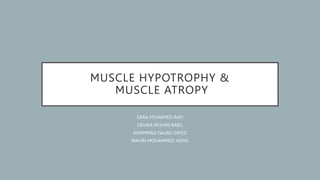
Muscle Hypertrophy.pptx
- 1. MUSCLE HYPOTROPHY & MUSCLE ATROPY SARA MOHAMED RAFI DEVIKA RESHMI BABU AHAMMAD NAJAD SAYED MAHIN MOHAMMED ADHIL
- 2. WHAT IS MUSCLE HYPOTROPHY? Muscular hypotrophy refers to the decrease in muscle mass or size. It can occur due to a variety of reasons such as disuse, malnutrition, aging (sarcopenia), or certain diseases.
- 3. WHAT IS MUSCLE ATROPHY? Muscular atrophy is the wasting or loss of muscle tissue. It can occur due to various reasons, such as 1) prolonged inactivity, 2) aging, 3) malnutrition, or 4) specific diseases and conditions.
- 4. DIFFERENCE BETWEEN THE TWO Increase in total mass of a muscle as hypertrophy, whereas a decrease in total mass of a muscle is referred to as atrophy.
- 7. CLINICAL SYMPTOMS – MUSCLE HYPERTROPHY Muscular hypertrophy, particularly in the context of resistance training and exercise, is generally considered a positive adaptation that leads to increased muscle size and strength. But extreme or abnormal cases of muscular hypertrophy, often unrelated to exercise, can be associated with certain medical conditions. • Hypertrophic Cardiomyopathy • Benign Prostatic Hyperplasia (BPH) • Muscular Dystrophy • Acromegaly • Pseudohypertrophy in Duchenne Muscular Dystrophy
- 8. CLINICAL SYMPTOMS – MUSCLE ATROPHY Muscle Weakness Reduced Muscle Size Physical Disability Muscle Flaccidity Decreased Mobility and Function Muscle Cramps and Stiffness Asymmetr y Fatigu e Unintentional Weight Loss
- 9. • Reversible Causes. • Chronic or Progressive Conditions • Neurogenic Atrophy • Age-Related Atrophy (Sarcopenia) • Individual Response to Treatment. • Early Intervention.
- 10. 1. Medical History 2. Physical Examination 3. Neurological Examination 4. Laboratory Tests 5. Imaging Studies 6. Electromyography (EMG) 7. Muscle Biopsy 8. Genetic Testing 9. Functional Assessments 10. Specialized Consultations
- 11. MANAGEMENT • Regular Exercise • Nutrition plan • Surgery for contracture • Ultrasound therapy • Electrical Stimulation • Balancing Hormone levels • Avoiding Steroid Abuse • Tumors or Masses • Removal of Tumors or abnormal • masses in muscles. • Physical Therapy • Medications
- 12. CASE STUDY-1
- 13. Background Sarah, a 35-year-old woman, presented to her primary care physician with concerns about unexplained muscle growth and weakness. She reported that over the past six months, she had noticed a significant increase in the size of her limbs, particularly her arms and thighs. Despite the apparent muscular hypertrophy, she experienced muscle weakness, fatigue, and occasional cramping. Clinical Examination • No significant history of intense physical training or resistance exercise. • No family history of muscular disorders. • Normal weight. • No history of recent infections or significant changes in medication. • Symmetrical muscular hypertrophy, particularly in the proximal muscle groups of the arms and thighs. • Muscle strength testing revealed weakness, especially in the affected muscle groups. • No signs of inflammation or joint abnormalities.
- 14. Diagnostic Workup 1. Blood Tests: • Creatine kinase (CK) levels: Elevated. 2. Imaging: • Magnetic Resonance Imaging (MRI) of affected muscle groups revealed hypertrophy without signs of inflammation or structural abnormalities. 3. Genetic Testing: • Screening for genetic mutations associated with muscular disorders (e.g., muscular dystrophies). Diagnosis After a comprehensive evaluation, Sarah was diagnosed with a rare form of muscular hypertrophy associated with a genetic mutation leading to overexpression of growth-related factors in muscle cells. This condition was causing muscle enlargement without a corresponding increase in strength, leading to weakness and fatigue. Treatment and Management Since the condition was genetic, there was no cure, but management focused on improving Sarah's quality of life. Physical therapy was recommended to maintain mobility and prevent muscle contractures. Regular monitoring of muscle function, CK levels, and overall health.
- 15. Conclusion This case illustrates a rare scenario where muscular hypertrophy is not a result of intentional exercise but is associated with an underlying genetic
- 16. CASE STUDY-11
- 17. Background • Mark, a 45-year-old man, presented to his primary care physician with complaints of progressive weakness, muscle wasting, and difficulty performing daily activities. He reported that over the past six months, he had noticed a gradual reduction in the size and strength of his muscles, particularly in his arms and legs. The symptoms had developed without any clear triggering events, such as trauma or prolonged immobilization. Clinical Examination • No significant history of recent injuries or surgeries. • No family history of neuromuscular disorders. • Normal weight. • No recent changes in medication or lifestyle. • Muscle atrophy, especially noticeable in the distal muscle groups of the arms and legs. • Muscle strength testing revealed generalized weakness, affecting both proximal and distal muscles. • Reduced range of motion in affected joints. • Normal sensation and reflexes.
- 18. Diagnostic Workup 1) Blood Tests: • Creatine kinase (CK) levels: Within normal limits. • Complete blood count (CBC), comprehensive metabolic panel (CMP): No significant abnormalities. 2) Neurological Testing: • Electromyography (EMG) and nerve conduction studies to evaluate electrical activity in muscles and nerve function. • Magnetic Resonance Imaging (MRI) to rule out structural abnormalities. 3) Endocrine Testing: • Thyroid function tests to rule out thyroid-related muscle disorders. 4) Autoimmune Markers: • Screening for autoimmune disorders that may affect muscles. Diagnosis After a thorough evaluation, Mark was diagnosed with a neurological disorder affecting the motor neurons, leading to progressive muscle atrophy. Further genetic testing revealed a mutation associated with a motor neuron disease.
- 19. Follow-Up • Mark continued to receive ongoing care and support from a multidisciplinary team, including neurologists, physical therapists, and occupational therapists. Regular assessments were conducted to monitor his muscle function, joint mobility, and overall well-being. Conclusion • This case illustrates a scenario where muscle atrophy is a result of an underlying neurological disorder with a genetic basis. A comprehensive diagnostic approach, including neurological and genetic testing, is crucial for accurate diagnosis and appropriate management. The focus is on providing supportive care to enhance the patient's functional abilities and maintain their overall quality of life.
- 20. THANK YOU